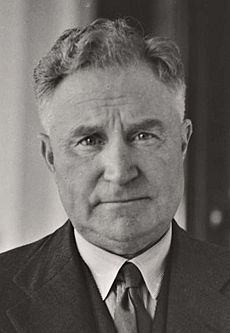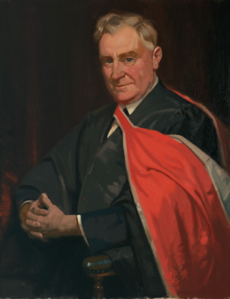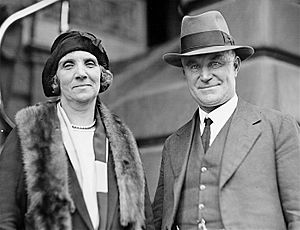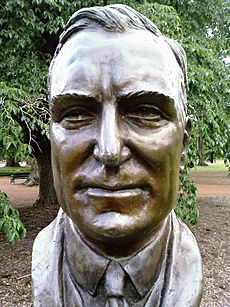Earle Page facts for kids
Quick facts for kids
Earle Page
|
|
|---|---|
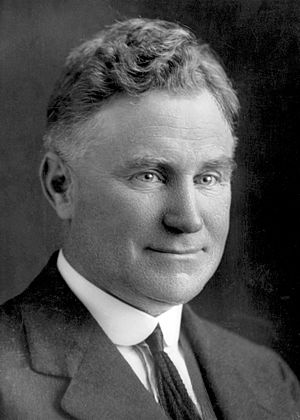
Page c. 1939
|
|
| 11th Prime Minister of Australia | |
| In office 7 April – 26 April 1939 |
|
| Monarch | George VI |
| Governor-General | Lord Gowrie |
| Preceded by | Joseph Lyons |
| Succeeded by | Robert Menzies |
| Leader of the Country Party | |
| In office 5 April 1921 – 13 September 1939 |
|
| Deputy |
|
| Preceded by | William McWilliams |
| Succeeded by | Archie Cameron |
| Minister for Health | |
| In office 19 December 1949 – 11 January 1956 |
|
| Prime Minister | Robert Menzies |
| Preceded by | Nick McKenna |
| Succeeded by | Donald Cameron |
| In office 29 November 1937 – 7 November 1938 |
|
| Prime Minister | Joseph Lyons |
| Preceded by | Billy Hughes |
| Succeeded by | Harry Foll |
| Minister for Commerce | |
| In office 28 October 1940 – 7 October 1941 |
|
| Prime Minister | |
| Preceded by | Archie Cameron |
| Succeeded by | William Scully |
| In office 9 November 1932 – 26 April 1939 |
|
| Prime Minister | Joseph Lyons |
| Preceded by | Frederick Stewart |
| Succeeded by | George McLeay |
| 11th Treasurer of Australia | |
| In office 9 February 1923 – 21 October 1929 |
|
| Prime Minister | Stanley Bruce |
| Preceded by | Stanley Bruce |
| Succeeded by | Ted Theodore |
| Member of the Australian Parliament for Cowper | |
| In office 13 December 1919 – 9 December 1961 |
|
| Preceded by | John Thomson |
| Succeeded by | Frank McGuren |
| Chancellor of the University of New England | |
| In office 8 February 1955 – 1960 |
|
| Deputy | Phillip Wright |
| Preceded by | Position established |
| Succeeded by | Phillip Wright |
| Personal details | |
| Born |
Earle Christmas Grafton Page
8 August 1880 Grafton, Colony of New South Wales |
| Died | 20 December 1961 (aged 81) Camperdown, New South Wales, Australia |
| Resting place | St Andrew's Cathedral, Sydney |
| Political party | Country |
| Spouses |
Ethel Blunt
(m. 1906; died 1958)Jean Thomas
(m. 1959) |
| Children | 5 |
| Relatives |
|
| Residences | Grafton, New South Wales, Australia |
| Education |
|
| Alma mater | University of Sydney |
| Occupation |
|
Sir Earle Christmas Grafton Page (born 8 August 1880, died 20 December 1961) was an important Australian surgeon and politician. He briefly served as the 11th Prime Minister of Australia for 19 days in 1939. This happened after the death of Prime Minister Joseph Lyons. Sir Earle was also the leader of the Country Party from 1921 to 1939. He played a big role in shaping the party in its early years.
Contents
Sir Earle Page: Australia's Former Leader
Earle Page was born in Grafton, New South Wales. He was a very smart student. He started university at just 15 years old. By age 21, he had finished his medical degree. After working at a hospital in Sydney, he went back to Grafton. There, he opened his own hospital. He quickly became involved in local politics. He also bought a share in a local newspaper. During World War I, he worked as a military surgeon.
Page became well-known for wanting to develop the Northern Rivers area. He was especially keen on using hydroelectricity (power from water). He also helped start a movement to create a new state called New England.
Starting a Political Career
In 1919, Earle Page was elected to the Federal Parliament. He represented the area of Cowper. The next year, he joined the new Country Party. He became its first whip. In 1921, he took over as the party leader.
Page did not agree with the economic plans of Prime Minister Billy Hughes. After the 1922 election, the Country Party held the balance of power. This meant they could decide who would form the government. Page demanded that Hughes step down. This was the condition for his party to join a government with the Nationalist Party.
Working with Prime Minister Bruce
After Hughes resigned, Stanley Bruce became the new Nationalist leader. Page then started talks with Bruce. Page asked for a lot: five spots in an 11-person cabinet. He also wanted to be the Treasurer of Australia and the second most important person in the government. These were big demands for a smaller party. But Bruce agreed to avoid another election.
Page became Treasurer from 1923 to 1929. He worked very closely with Prime Minister Bruce. Page was like the first Deputy Prime Minister of Australia, even though the title didn't exist yet. He was also acting prime minister several times. In 1924, he led the first meeting of the Federal Cabinet ever held in Canberra.
As Treasurer, Page helped make many changes. The government removed land tax and cut income tax. They also set up a national fund to pay off government debts. Page also helped create a fund for scientific research. He supported a national housing program too.
Page believed in careful financial management. He also supported tariffs to protect Australian industries. He made changes to the Commonwealth Bank to help it act like a central bank. This included putting the bank under an independent board. In 1925, Australia returned to the gold standard.
In 1924, Bruce and Page created the Loan Council. This group helped state and federal governments borrow money in a planned way. They also started giving money to states for specific projects, like building roads. Page also supported a plan for national insurance. This plan would have provided benefits for sickness, old age, and maternity. However, the government lost the 1929 election before the plan could become law.
A Short Time as Prime Minister
The Bruce-Page government lost the 1929 election. Page then became part of the opposition. In 1931, Joseph Lyons formed the United Australia Party (UAP). Lyons won the 1931 election. He wanted to work with the Country Party, but they couldn't agree.
In 1934, the UAP lost some seats. This made Lyons need the Country Party's support again. So, they formed a new coalition government. Page became the Minister for Commerce. He focused on issues important to farmers. In 1938, he was made a Knight Grand Cross. This was a special honour.
When Prime Minister Lyons suddenly died in 1939, Governor-General of Australia Lord Gowrie asked Page to be caretaker Prime Minister. He held the job for three weeks. This was until the UAP chose a new leader, Robert Menzies.
Page had been close to Lyons. But he did not like Menzies. He publicly accused Menzies of not being loyal to Lyons. Page even offered to give up his own seat if Stanley Bruce would return to politics. Bruce was in London at the time.
When Menzies became UAP leader, Page refused to work under him. He even made a strong personal attack on Menzies in Parliament. But his own party disagreed with him. Page was removed as Country Party leader after only a few months. Archie Cameron took his place.
His Role in World War II
In March 1940, the Country Party joined the UAP again. Page became the Minister for Commerce once more. In August 1941, Arthur Fadden became Prime Minister. A few weeks later, Page was sent to London as a special minister. He was meant to work with the British War Cabinet.
While Page was traveling, the Australian government changed. John Curtin became the new Prime Minister. But Curtin still let Page take up his role in London. The attack on Pearl Harbor in December 1941 changed everything. The war in the Pacific became Australia's main concern. Page helped create the Pacific War Council.
Page helped smooth things over between Winston Churchill and John Curtin. Curtin wanted Australian troops to return home from the Middle East. Page helped explain Australia's needs. However, he made a mistake in February 1942. He wrongly told Churchill that Australian troops could go to Burma instead of directly home. Curtin and his foreign minister were very upset.
Page left London in June 1942 because he was sick. He was given a special honour, the Order of the Companions of Honour (CH). He returned to Australia in August. He then started planning for Australia after the war. Page's brother and nephew were killed by the Japanese during the war.
Helping Australia's Health
After the Coalition won the 1949 election, Page became Minister for Health again. He was 69 years old. He was the main person behind the National Health Act 1953. This law created a national health system. It helped people pay for private health insurance. It also gave free medical services to pensioners.
Page was important in getting doctors to support the plan. Doctors had been against the previous government's idea for universal health care. In 1951, a senator had a stroke in Parliament. Page, being a trained surgeon, rushed to help him.
In 1954, Page became the first leader of the University of New England. He retired from his cabinet role in January 1956, at the age of 76. He continued to serve as a Member of Parliament.
Later Years and Legacy
By the 1961 election, Page was very ill with lung cancer. Even though he was sick, he refused to retire from Parliament. He ran for his 17th election. But in a big surprise, he lost his seat to Frank McGuren. Page had held the seat of Cowper for almost 42 years. This made him one of Australia's longest-serving politicians.
Page went into a coma a few days before the election. He died on 20 December 1961, just 11 days after losing his seat. He never knew he had been defeated.
Page was the last former Prime Minister to lose his seat until 2019. He made sure the Country Party stayed independent. He pushed for ideas like decentralisation (spreading out power) and supporting farmers. These ideas are still important to the party today. The partnerships he formed with Bruce and Lyons became a model for future coalition governments in Australia.
Personal Life
Earle Page married Ethel Blunt on 18 September 1906. They met when he was a medical resident and she was a senior nurse. Ethel stopped nursing after they married. But she was very active in politics and community groups. They had five children: Mary, Earle Jr., Donald, Iven, and Douglas. His grandsons include Don Page, a politician, and Geoff Page, a poet.
Page's first wife, Ethel, died in 1958. His oldest son, Earle Jr., died in 1933 from a lightning strike. On 20 July 1959, Page married his long-time secretary, Jean Thomas, in London. Stanley Bruce was his best man. Jean lived for almost 50 years after Earle's death.
Awards and Recognitions
Earle Page received many honours during his life:
- In 1929, he became a member of the Privy Council of the United Kingdom (PC).
- In 1938, he was made a Knight Grand Cross of the Order of St Michael and St George (GCMG).
- In 1942, he became a member of the Order of the Companions of Honour (CH).
- In 1942, he was made an honorary Fellow of the Royal College of Surgeons of England (FRCS).
- In 1952, the University of Sydney gave him an honorary Doctor of Science degree.
- In 1955, the University of New England also gave him an honorary Doctor of Science degree.
Several places and things are named after him:
- The Division of Page – a federal election area that includes Grafton.
- Page, Australian Capital Territory – a suburb in Canberra.
- The Sir Earle Page Library and Education Centre in Grafton.
- Earle Page College – a student residence at the University of New England.
- Page Chest Pavilion – a building at Royal Prince Alfred Hospital (now demolished).
- Page Research Centre – a research group linked to the National Party of Australia.
Images for kids
See also
 In Spanish: Earle Page para niños
In Spanish: Earle Page para niños


